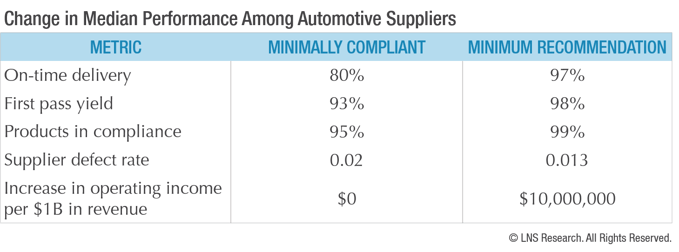Ideally, compliance is part of your strategy, but not your entire strategy. It's not enough to produce a safe product, that works as intended, and meets regulatory requirements. Today’s quality leadership must contribute to the firm’s reputation, competitive standing, profitability, and growth. Adding to the burden, your company’s industry, target market, role in the supply chain, size, and so many other factors intensify the pressure. Yes, it’s a complex web of codes, guidelines, standards, and practices that companies face:
- FDA 21 CFR part 820
- AS9100 for aerospace
- ISO 13485 for medical devices
- ISO/TS 16949 for automotive
- Long list of CGMP for pharmaceutical
- Many others
Quality executives that only focus on regulatory compliance and customer requirements will probably miss the mark on turning quality into a competitive advantage. It requires a shift in thinking and a new strategy, so think about which of these five mistakes you’re making today, how it affects your company, and what you might want to do differently.
MISTAKE #1 | You’re worried about compliance instead of enterprise performance.
When our analysts examined the market, they found out that companies that focus first on enterprise performance usually exceed compliance requirements. As an example, in the automotive industry, when top corporate executives prioritize quality, companies exceeded best practices required for compliance ― with a best practices adoption rate of three to one over those that did not. They hit all the compliance requirements, PLUS improved on-time delivery, first pass yield, products in compliance, supplier defect rate, and operating income. Quality leaders should help corporate executives understand that quality isn’t just a “cost of doing business” but rather an activity that can add significant value to the corporation.

MISTAKE #2 | You’re not using a risk-based approach to supplier management.
(Or, if you’re a supplier you’re not thinking like your customer.)
Twenty-one percent of manufacturers say that supply chain visibility blocks quality objectives. If you’re an OEM, that means you might not have all the relevant facts to decide which suppliers are top performers, which ones are average, who’s on the fringe, and which relationships you need to end. If you’re a supplier, be forewarned that customers are always going to be concerned about their supply chain and supply chain risk.
When companies standardize risk tools and access data from across the enterprise and outside the company four walls, they increase the long-term success of the supplier quality initiative. Quality 4.0 leaders use that data to assess, quantify, prioritize, and mitigate supplier risk, and they’re in a better position to eliminate supply and production disruptions to meet their on-time delivery and new product introduction goals. Have you considered the impact of Quality 4.0 on your approach to supplier management?
MISTAKE #3 | You don’t know how your company stacks up on the capabilities maturity model.
According to Principal Analyst Dan Jacob, “Companies planning to invest in IIoT for quality or supplier performance improvement should ensure that quality management is sufficiently mature to fully realize the potential for investments.” Yes, you might know what you're aiming for (e.g., align with corporate Strategic Objectives), but if you don't know what capabilities you have, and where the gaps are, it's going to be difficult to achieve results. During conversions with Dan, he recommended the following steps for assessing and planning for quality maturity:
- Get educated about what constitutes quality management maturity
- Benchmark capabilities across people, processes, and technology
- Use the benchmark to quantify your current state and the value of each higher level
- Evaluate how each level of quality maturity growth will affect the organization and quantify the impact on each functional area and to the corporation
- Map out a growth strategy, and communicate it across functional areas of the organization, and to corporate executives
MISTAKE #4 | You’re not looking outside your industry for ideas and best practices.
It makes perfect sense that pharmaceutical manufacturers look to other life sciences companies for proven best practices, automotive suppliers look to the car manufacturing industry to see what works, and so on. When was the last time you looked outside your unique sector to see what’s working for other companies? When planning for capabilities maturity, keep in mind that companies at Level 4 and Level 5 have a substantial competitive advantage over the rest of their market, particularly in terms of on-time delivery (OTD) and overall equipment efficiency (OEE). Again, using the automotive industry as an example, among companies that focus on operational excellence instead of just compliance:
- OTD jumps from 80% to 97%
- First pass yield goes from 93% to 98%
- Compliant products (meets all customer and regulatory requirements) goes from 95% to 99%
The operational gains translate to financial gains: for every $1B in revenue, it’s a $10M impact to operating income. Bottom line: your competition probably isn’t looking outside the industry, so apply what you can from other verticals as a secret weapon to get ahead.
MISTAKE #5 | Your team is focused on getting the “right software” instead of transforming the business.
Our analysts say it all the time: "Don't get sidetracked by putting solution selection too early in the process." Yes, technology might be a challenge in your organization, but it's likely not the only one you face. One CQO of a $20B manufacturer our analysts talked with said he's going to consolidate the company's enterprise quality management system (EQMS), but that wasn't the only thing he was working on. Before the company ever set out to get technology aligned, it had to line up the quality initiative with corporate Strategic Objectives. Whatever your company’s vision is for Industrial Transformation – new business model, product innovation, brand reputation, or something else – that’s your queue for getting quality on the right track.
Ultimately, when you set a goal for quality – and allow compliance to fall in line behind it – you will have a meaningful, and perhaps profound impact on your business.